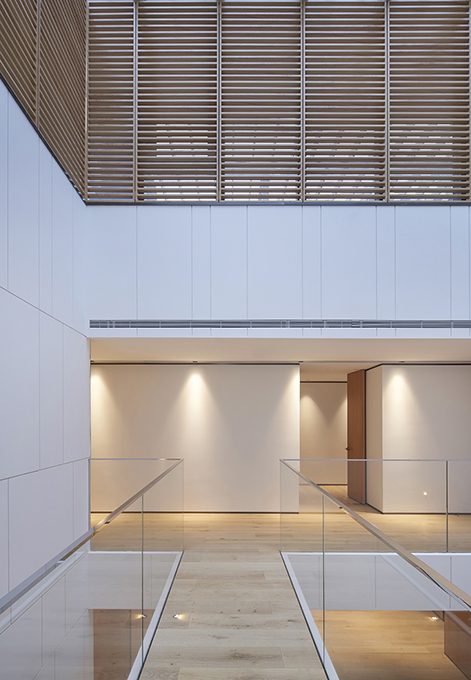放空心灵的当代居所---顶层复式大宅设计 Contemporary Lakeside Residence in Suzhou
获奖者:
高亮

作品简介:
放空心灵的当代居所
--- 顶层复式大宅设计
设 计:高亮
设计内容:建筑改造、幕墙改造、室内设计
地 点:苏州金鸡湖畔
面 积:约860平方米
主要材料:古堡灰大理石、橡木地板、橡木饰面板、白色墙面漆等
竣工时间:2018.12
设计主题:去风格化的自然设计哲学
本案位于苏州金鸡湖北侧一栋30层公寓的顶层,建筑面积约为860平方米。
金鸡湖是国内最大的城市中心湖泊,处于这座现代花园城市的中心,位置优势无疑是本案的亮点。经过和业主多次讨论,设计方向确定为---打造一所拥抱自然、放空心灵的当代居所。朴素、内敛、简约、自然;最大限度与环境融合;避免过度装修和过于风格化,以此作为设计宗旨。
首层平面布置借鉴了苏州园林的住宅布局。一进会客、二进起居、三进用餐,将服务通道设在一侧,串联起三重空间,通道后侧设辅助功能区,避免流线冲突。面向金鸡湖的露台立面改造成三轨可开启移门,最大限度的连接室内和室外空间。通过结构改造,接待厅与主通道交汇处形成一个近30平方米的天井,充足的阳光使层高有限的大进深空间变得宽敞明亮起来。苏州地区冬冷夏热,夏季天井中热气流上升形成气流循环,可以有效加快空气流动达到体感舒适;冬季阳光通过天井进入住宅的中心,暖意油然而生。
本案综合考虑了业主的使用需求和精神寄托;缩减能耗的环保信念;功能与形式的平衡;风格化与永续性探索。设计从人与住宅的相互关系出发,关注环境、内涵、功能、品质,尝试从生活到建筑的空间再生,以期实现当代大宅的经典性和永续性,最终呈现出自然且持久的住居美学。
Contemporary Lakeside Residence in Suzhou
Designer: Gao Liang (Gary Gao)
Project: Lakeside residence in Suzhou
Location: On the waterfront of Suzhou’s Jinji Lake
Floor Area: 860 square meters
Main materials: Granite, marble, oak flooring and veneer, paint wall
Work scope: Structural alteration, interior design, landscape design and soft decoration
Completion: December 2018
Photographer: DM Photographs + Films
Design Theme: De-stylization naturalistic design strategy
Situated in Suzhou Industrial Park – the modern centre of Suzhou, the 860 sqm penthouse is on the 30th floor of a landmark residential tower on the lakeside of the famous Jinji Lake, overlooking the attractive lake view and surrounding vibrant entertainment and shopping amenities.
Jinji Lake is the largest urban lake in China, which is regarded as one of the most valuable features of Suzhou. Facing the blue waves and the new bustling city center, location is undoubtedly the most advantageous characteristic of the project, how to maximize the environmental value, respond to the external context in a simple but refined design language is the design focus of this residence. Seeking simple, restrained and naturalistic design solutions, maximally embracing the natural environment, avoiding over-decoration and excessive stylization are set as the ultimate goals to achieve in the residence interior design, which is recognized by both the client and the designer.
Pay tribute to classic space creation, the layout of common space on the first floor draws on the layout of living space of Suzhou classical gardens. The garden style circulation starts from the vestibule, then guest lounge, living room and dining room, well ordered and progressively planned. The main service path is set on one side, connecting in series the multiple spaces. The guest lounge is located at the intersection of the north-south and east-west axis of the whole residence, and naturally becomes the core of the first floor. The intersection of the west side of the hall and the service path form a 30 square meters patio, and the lower part of which is reserved as the corresponding patio garden. Sitting on the teahouse in the guest lounge, the breeze blurs the indoor and outdoor, and the plantation on the terrace creates a natural and easing ambience, giving hosts and guests a feeling of being in the "the Pavilion in the Lotus Breezes" (the famous scenic spot of Humble Administrator’s Garden in Suzhou). In addition, the terrace fa?ade facing the Jinji Lake has been converted into open sliding doors to maximize the connection between interior and exterior spaces.
In terms of minimizing energy consumption, the patio created through structure alteration helps to adjust microclimate, particularly reducing the uncomfortableness in summer and winter. In summer, hot air flow rises in the patio, which can accelerate airflow circulation and bring a comfortable feeling. In the winter, sunshine enters the center of the residence directly through the patio, effectively enhance the indoor temperature.
The case is an exploration of stylization and sustainability, which comprehensively considers the client’ living needs and spiritual sustenance, balance of functions and forms, and eco-friendly solutions. Compared with the highly stylized and gorgeous “mansion”, the design of this residence is more about a complete process of spatial regeneration from indoor to architectural. Re-exploring the relationship between human and space, focus on need, function, connotation and quality, to achieve classic and sustainable residence for mind, body and soul. At the meantime, the relatively simple decorative materials are selected, through color matching, mutual combination and exquisite processing, the natural and long-lasting living aesthetics is finally presented.
